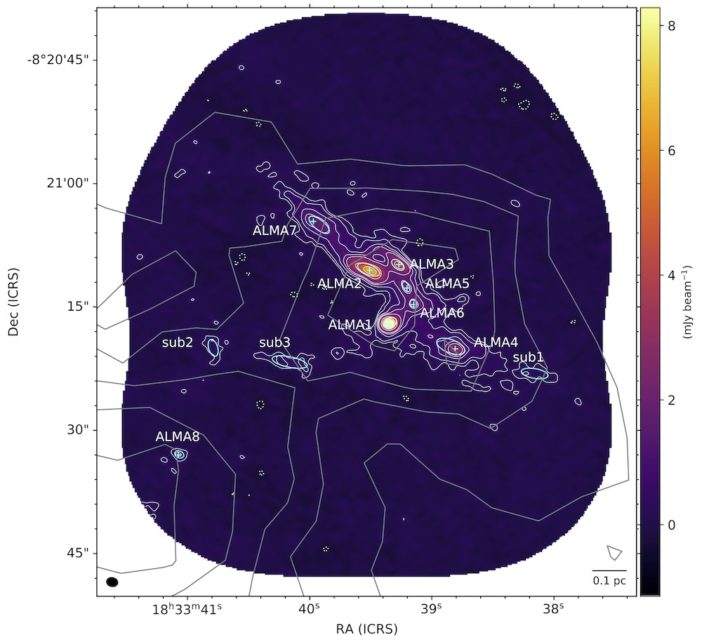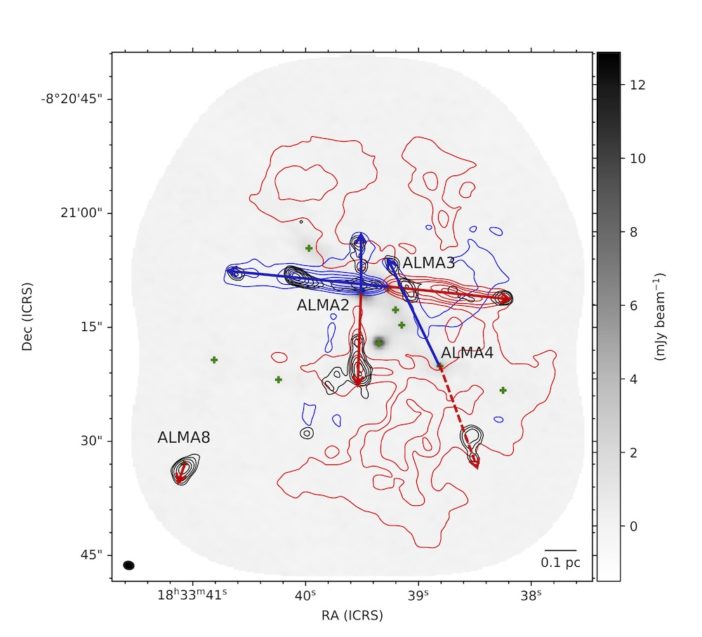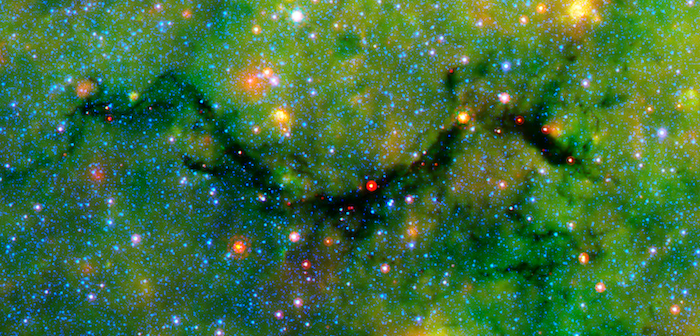Editor’s note: Astrobites is a graduate-student-run organization that digests astrophysical literature for undergraduate students. As part of the partnership between the AAS and astrobites, we occasionally repost astrobites content here at AAS Nova. We hope you enjoy this post from astrobites; the original can be viewed at astrobites.org.
Title: The ALMA Survey of 70 μm Dark High-Mass Clumps in Early Stages (ASHES). IV. Star Formation Signatures in G023.477
Authors: Kaho Morii et al.
First Author’s Institution: The University of Tokyo, Japan
Status: Published in ApJ
Despite attempts to probe the early stages of massive star formation, those critical phases are still shrouded in mystery. Massive stars (greater than 8 solar masses) enrich the interstellar medium with heavy elements expelled through stellar winds and eventually collapse and release even more material through supernovae. That’s why understanding their formation is essential for understanding the entire feedback cycle within the universe.
Massive stars form out of dense “cores” of material. One promising area for hosting such cores is the infrared dark cloud IRDC 18310-4. In today’s article, the authors use data from the Atacama Large Milllimeter/submillimeter Array (ALMA) Survey of 70-µm dark High-mass clumps in Early Stages (ASHES) to look at the cloud and what may be hidden within.
Getting to the Core(s) of the Problem
The authors begin by examining an ALMA image of the cloud (see Figure 1), which shows the continuum dust emission at 1.3 mm. The main cloud is in the brightest part of the image near the center, running from the upper left to the lower right. The white contours trace the emission and are concentrated in the areas where it is brightest.
Using this image and specific requirements for brightness and spatial separation, the authors determine that there are 11 cores within the cloud, which are marked in Figure 1 by the cyan ellipses. They label the brightest cores ALMA1–ALMA8 and the other cores sub1–sub3. These cores are important because they’re the most likely sites for future (or maybe even current!) massive star formation.

Figure 1: The ALMA dust continuum emission at 1.3 mm. Contours show the increasing flux in the cloud, which runs diagonally from the upper left to lower right. Cyan ellipses mark the 11 cores (labeled ALMA1–ALMA8 and sub1–sub3) that may host the earliest stages of massive star formation. [Morii et al. 2021]
CO and Important Outflow
The authors also looked at different molecular emission lines in the cloud, which allowed them to estimate the properties of each core. Emission lines help determine gas temperature because the presence of more energetic emission lines means the gas is hotter. Core mass was also determined using the velocity dispersion of the molecular lines. Additionally, past studies have found that molecules like CO and SiO trace outflows and shocks.
To find outflows in the image, the team separated the redshifted and blueshifted components of the CO emission. Figure 2 shows the same dust continuum map as Figure 1, but in grayscale. Green crosses mark the locations of the highest continuum emission. A few of the cores are labeled. The red and blue contours highlight the integrated redshifted and blueshifted CO emission. The black contours demonstrate the areas with the greatest SiO emission.

Figure 2: The same image as Figure 1, but in grayscale. The red and blue contours show the red- and blue-shifted CO emission. Black contours trace SiO emission. The arrows show the inferred outflows of material present in ALMA2, ALMA3, ALMA4, and ALMA8. [Morii et al. 2021]
Sorting Cores
The authors of today’s article sort the cores into three main groups based on their measurements of molecular emission lines.
- Protostellar cores that have both high temperatures and outflows: ALMA2, ALMA3, ALMA4, and ALMA8.
- Protostellar core candidates that have high temperatures but no outflows: ALMA1 and ALMA5.
- Prestellar core candidates that have neither high temperatures nor outflows: ALMA6, ALMA7, and sub1–sub3.
Basically, the higher the temperature, the older the protostar, since it warms the surrounding material in the core as it evolves. ALMA8 has the highest temperature of the cores, so it’s likely the most evolved. The protostellar core candidates might represent an extremely early phase of star formation before outflows begin. The prestellar core candidates might one day start to form protostars, but for now they’re probably just clumps of gas and dust.
Looking Ahead with ASHES
While this is a study of only one cloud, the complete ASHES project will explore many similar structures and may enable statistical studies of the earliest stages of massive star formation. That will help constrain how and where massive stars form, a crucial aspect of understanding how the universe evolves.
Original astrobite edited by Luna Zagorac.
About the author, Ashley Piccone:
I am a third-year PhD student at the University of Wyoming, where I use polarimetry and spectroscopy to study the magnetic field and dust around bowshock nebulae. I love science communication and finding new ways to introduce people to astronomy and physics. In addition to stargazing at the clear Wyoming skies, I also enjoy backpacking, hiking, running, and skiing.
